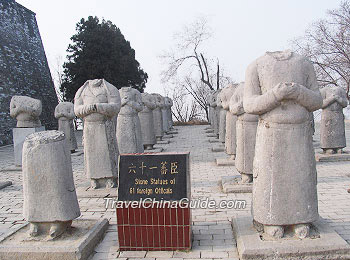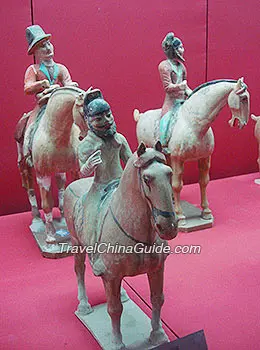Tang Foreign Policies & Relationship Between Ethnic Groups
Diplomatic Relations
 |
| Stone statues of 61 foreign officials in Qianling Mausoleum, Tang Dynasty |
Tang's World Status
Relationship with Japan
In return, many Chinese Buddhist monks also traversed the sea to Japan, making contributions to cultural exchanges between the two countries. Particularly, a Buddhist monk named Jian Zhen, along with his disciples, made six attempts before succeeding at the arduous journey to Japan. In his seventies and being blind, Jian Zhen spread the Buddhist temple architecture, the art of sculpture and painting to Japan. As a master of medicine, Jian Zhen also made great contributions to the Japanese medical development.
In the field of politics, education and language formation, Japan modestly learnt a lot from Tang society. Referring to the Juntian Zhi (land equalization policy) and Zuyongtiao Zhi (tax modification system) of the Tang Dynasty, Japanese rulers carried out new land laws and their own Zuyongtiao System. Its official system and law system also imitated that of the Sui and Tang dynasties. In education, the Mikado of Japan set up universities, with all the subjects similar to that of the Tang Dynasty. Before the 8th century, in language, the Japanese people used Chinese characters as the expression tools. Later, a Japanese student and a knowledgeable monk created the Japanese kana alphabet, namely Hiragana and Katakana. Additionally, Japanese vocabulary and grammar were deeply influenced by those of Chinese language.
Relationship with Gaoli, Xinluo and Baiji
At first, the Tang court got on well with all three countries and sent envoys there. In order to help Xinluo to fight against the other two countries, Emperor Taizong began to attack Gaoli in 644. However, none of the expeditions to Gaoli succeeded before Emperor Taizong's death in 649. During Emperor Gaozong's reign, Tang' army made alliance with Xinluo's army and defeated Baiji. In 668, Tang's army defeated Gaoli, capturing its capital city, Pingrang. Before long, under the pressure of domestic ethic minorities and former Gaoli's military force, Tang's army gradually retreated from Korean Peninsula.
In 675, Xinluo unified the Korean Peninsula. Since then, the Tang court and Xinluo had established a friendly relationship. Among other foreign countries having diplomatic relations with China, Xinluo had the most students studying in Chang'an (currently Xi'an) and had the largest trade volume with China. Meanwhile, both countries benefited from cultural exchanges. Tang envoys to Xinluo conveyed silk, porcelain, Chinese tea and engraving typography, while Xinluo's envoys came to China, bringing medicinal materials, handicraft articles, bezoar, Korean ginseng and Korean music.
Relationship with Ethnic Minorities
 |
| Painted Pottery of Foreign Horsemen, Tang Dynasty |
Generally speaking, there were four main policies by which Tang court dealt with ethnic groups. The first one was the military expedition, dealing with the ethnic Aristocrats who harassed Tang's border areas. The second one was letting the ethnic minority leaders govern their local areas, along with the management of Tang court's administrative bureau. The third one was marrying Tang princess to ethnic groups' leaders, enhancing the bilateral feelings. The fourth one was trading and paying tribute to each other. Tang used to trade Silk and paper with Huihe's horses.
Relationship with Tujue
After the downfall of the Tujue, the Tang court set up four provincial military institutions in Tujue's previous area where more than a hundred thousand Tujue people were settled. Meanwhile, six 'zhou' (province in Tang Dynasty) were established in currently Inner Mongolia. Former headmen of the Tujue were still appointed by the Tang court to govern their local area. It was said that approximately ten thousand Tujue families had migrated to capital Chang'an. Additionally, more than a hundred Tujue aristocrats were nominated as generals and some other high military officers.
Relationship with Xue Yantuo and Huihe
Compared with Huihe, Xue Yantuo had a much stronger military force. In 628, the leader of Xue Yantuo, Yi Nan, defeated four generals of Tujue and was honored as Khan. Later, Emperor Taizong conferred on him the title of Zhenzhu Pijia Khan and made alliance with Xue Yantuo to fight against Tujue. Since the downfall of Tuejue, Xue Yantuo had become the main power in the Mobei area. In 645 Yi Nan died and the throne was passed to Duo Mi, a tyrant whose ruling caused domestic chaos. In 646, both Huihe and Tang launched a war against Xue Yantuo, killing Duo Mi and ending the Xue Yantuo regime.
Later, Huihe and some other tribes that belonged to the Tiele group attached to the Tang Dynasty. In 647, Emperor Taizong divided the Mobei area into six 'fu's and seven 'zhou's. During that period, Tang's administrative region expanded to the entire Mobei area and all the local ethnic leaders honored Emperor Taizong as 'Tian Khan' (king of the sky).
Relationship with Tubo
In 629, a young headman aged thirteen and named Songtsan Gambo began to rule his group. In his ruling, the whole of Tibet was unified and the Tubo Dynasty was founded. It was in his reign that contact between Tang and Tubo was initiated and reached an unprecedented level. In order to propose marriage towards Tang, Songtsan Gambo sent an envoy with copious gold and treasures to Chang'an in 640. Willing to make friendly relationship with Tubo, Emperor Taizong agreed to marry Wencheng Princess with Songtsan Gambo.
Following the marriage of Wencheng Princess and Songtsan Gambo, the economical and cultural exchange between Tang and Tubo had been greatly accelerated. When the princess went to Tubo, she carried many vegetable seeds, handicraft articles, brewing and textile techniques, which had helped to improve Tubo's agriculture and handicraft industry. Meanwhile, merchants from Tubo bought lots of silk, paper and military arrows from the Tang Dynasty.
An important thread that linked Tang cultural and Tubo culture was the faith of Buddhism. The formation of Tubo's Buddhism was based on Tianzhu (currently India) Buddhism, Nipoluo (currently Nepal) Buddhism and Buddhism from Tang. Among them, Buddhism from Tang was more suitable to Tubo's local culture. On this basis, Tubo developed its own Buddhist culture which was specifically the predecessor of Tibetan Buddhism. Historical records clarify that when Wencheng Princess entered Tubo, she also brought a figure of Sakyamuni and 360 Buddhist classical sutras with her. Additionally, Tubo used to send envoys to visit Tang's temples including Buddhist temples in Wutaishan Mountain and Da Ci'en Temple in Big Wild Goose Pagoda. Later, Tubo people built their own Buddhist temple - the Jokhang Temple in current Lhasa.
Relationship with Nanzhao
During Nanzhao king Pi Luoge's reign, Nanzhao defeated the other five 'zhao's and established a unified Nanzhao nation, with Dali as its capital. In 738, Emperor Xuanzong of Tang honored Pi Luoge as Yunnan Wang (king of Yunnan area). From then, Nanzhao became the most powerful regime that had been set up by ethnic minorities in Southwest China.
The unified Nanzhao society developed rapidly. Due to communication with Tang, the textile, architecture and political system were greatly improved. Textile workers from Chengdu helped a lot with the textile techniques in Yunnan. Most constructions in Nanzhao imitated Tang's architecture. The well-known Three Pagodas in Chongsheng Temple of Dali were designed and built by Tang craftsmen. Referring to Tang's political system, Nanzhao established a well-organized political structure. Especially, following the Tang court, rulers of Nanzhao also carried out Juntian Zhi.
However, Nanzhao was a country at war with others. Since the unification, Nanzhao and Tubo endured a long-time struggle until 794 when Nanzhao broke away from the oppression of Tubo. From 830, Nanzhao began to war with Tang, during which period Nanzhao captured Chengdu, causing a great loss to the Tang Dynasty.
- Last updated on Aug. 08, 2025 by Gabby Li -